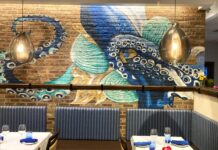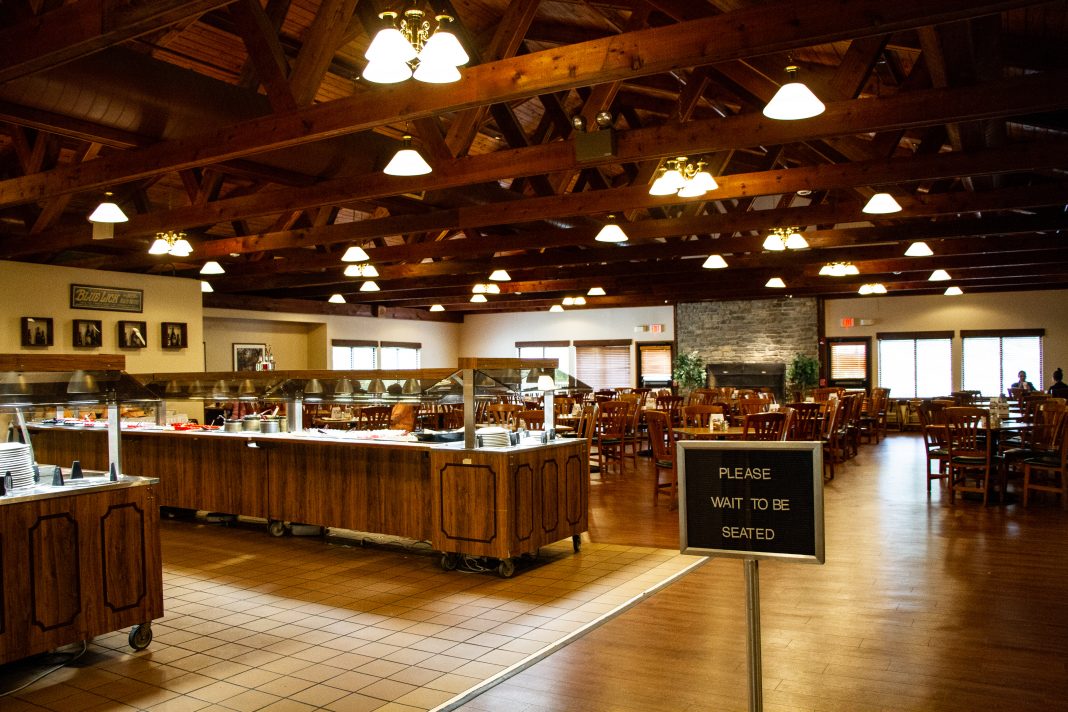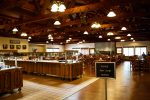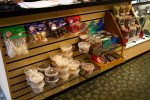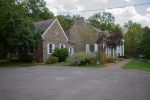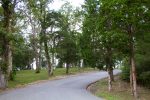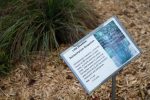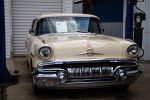According to the State Parks website, “On August 19, 1782, nearly seventy Kentuckians died in what some historians have called the “Last Battle of the American Revolution.” While that claim is debatable, the struggle at Blue Licks embodies the conflict between the American Indian, Kentucky settlers, and the British Crown.”
You can read more about the history of the park here, but the battle isn’t the only interesting historical fact about this state park, though. A friend and I made the drive (just over 2 hours) from Louisville to Blue Licks Battlefield State Resort Park to try the German influenced meal on the Taste of the Bluegrass Culinary Trail. We entered the large dining room and enjoyed a lovely view of a giant stone fireplace, which we were seated in front of.
The $10.99 meal might be the most sparse of the trail offerings. It has the option to add on a $9 Kentucky Rain cocktail, which features maraschino cherries atop sprite, Blue Curaçao, and Casa Amigas Tequila (a Tequila created by Rande Gerber, Mike Meldman and Lexington born actor and celebrity George Clooney).
We had just a taste of the cocktail, which was definitely too strong if we were going to make the long drive home. Park Manager Rob Mack said it is why many of the travelers who come for the heritage meal skip the optional beverage.
The first course was a dish I’d never had before: tomato pie. I wasn’t quite sure what to expect, but it was really like a quiche – except it didn’t have egg. It does have a creamy mayonaisse and cheese topping over tomatoes and vegetables in a pie crust, though, making it a very savory dish.
The tomato pie was followed by a sparse plate with two small potato cakes, two tomato slices and two patties of goetta – a mushy sausage. That’s really how it’s described. It’s a mush of grain and sausage. This dish is quite popular in Northern Kentucky and Cincinnati and comes from German tradition. IT was originally a peasant dish meant to spread out meat servings and is a bit bland in flavor. It isn’t my favorite type of sausage but was prepared well.
The final course was transparent pie. It is very sweet as it is mostly sugar. Made popular by Magee’s Bakery in Maysville, this pie is similar to sugar pie in Indiana or shoofly pie in Pennsylvania as explained by NPR. It’s really just eggs, sugar, milk and a little bit of flour. It is kind of gooey in texture.
Like most of the state parks, the buffet is quite popular. He said they serve 500 people a day on their senior Tuesdays when they offer a $6.99 buffet. Their most popular items are catfish, green beans, mashed potatoes, and banana pudding. Every third Tuesday of the month also features a jam session where local musicians come and play.
We visited the gift shop after our meal, which had a good selection of Kentucky proud products and cookbooks like Pappy’s BBQ sauce, Maker’s Mark, and “Shurshot” Moonshine hot sauce. I picked up some small bottles of the hot sauce, which are packaged in cardboard shotgun shells. I figured they would be fun to send to out -of-state acquaintances, furthering the misperceptions of everyone I’ve invited to our state that I (and everyone else) am a barefoot person who survives on what I kill with my shotgun (decorated with hot sauce and barbecue) and drinks only moonshine or bourbon. Nevermind the sauce is made in Alabama. A girl’s got to keep up appearances.
Being Tuesday, we found the museum closed. We took a moment to enjoy the beautiful stonework of the museum and stairs leading to it and the signs identifying plants like “Big Blue Stem” and “Little Blue Stem.” Sometimes you just say what you see, I guess.
I did read more online about some really cool history Mack had told us about. The land used to have a natural spring and the Arlington was a three-story hotel during the 1800s, which provided lodging for wealthy southern guests who traveled to partake in the healing mineral waters.
“There was a large dining room where lavish banquets were served, a ballroom, and an observation building shaped like a bird cage and featuring a cupola. The Arlington Hotel burned in 1862 and the Blue Licks Springs area began to decline in popularity. A few smaller hotels remained after the Civil War and regained popularity during the middle 1870s and early 1880s. However, the primary business at Lower Blue Licks after the Civil War was bottling mineral water. “
The spring went dry in 1896, which led to local landowner Thomas Hunter digging to see if he could find the spring waters deeper in the earth. Instead, he found animal bones and fossils. A team later excavated two carts of animal bones and other items in 1945, including a Mastadon tusk that was more than 3-feet long and weighed more than 100 pounds. These items are on display in the museum.
Unfortunately, I had been fighting a fever, so we didn’t attempt any of the five miles of hiking trails, which is one of the few things to do at this park aside from miniature golf. The trails go through the battlefield area, the former hot springs area, and through a buffalo trace. Mack said they are also working with some National Guard members to create an orienteering course, so families can learn to navigate their way from point to point with a compass.
The park may not have as many things to do as some of the other state parks, but Mack says they keep it very basic which he says makes their profitability the best in the park systems.
“It’s quiet. Our staff is friendly. That’s kind of our selling point. You can get away here.”
We decided to head for home with just one more stop. On our drive in, my friend thought I was having a seizure when I started excitedly pointing and asking her to turn into a parking lot boasting some beautiful classic cars. She had already passed the turn in, so we made a point to stop on the way back, allowing me to drool at the mechanical beauties at Central Kentucky Classic Cars. Sales Manager Jason Dotson met us in the lot and told us they actually sell quite a few of their cars to buyers in Texas and even Europe.
Perhaps one of the most impressive observations from the trip was miles and miles of stone walls running alongside the road back to the expressway. They stretched on for what seemed like an unbelievable distance, and it made me wonder if all of those stones had been drug from creek beds over a hundred years ago.They definitely transported my thoughts to the days of pioneering when Daniel Boone came to the area with teams and boiling kettles to make salt at the salt licks in the area.


